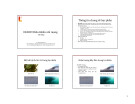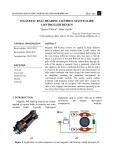
ISSN: 2615-9740
JOURNAL OF TECHNICAL EDUCATION SCIENCE
Ho Chi Minh City University of Technology and Education
Website: https://jte.edu.vn
Email: jte@hcmute.edu.vn
JTE, Volume 20, Issue 01, 02/2025
51
A Study on Increasing of Heat Flux for Heat Sink in VRF Outdoor Inverter
Board
Hoai-An Le , Minh-Hung Doan*
Ho Chi Minh City University of Technology and Education, Vietnam
*Corresponding author. Email: hungdm@hcmute.edu.vn
ARTICLE INFO
ABSTRACT
Received:
08/06/2024
Increasing of heat flux for heat sink in VRF outdoor inverter board helps
to increase heat sink performance, prevent over heat error caused by
inverter board. For these reasons, the heat sinks are carried out to
experimentally study, propose an R22 air conditioner model with the heat
sinks in conditions of different hydraulic diameter (Dh), copper tube
quantity (n). Three samples are same length L (150 mm), W (140 mm),
HS1 sample has Dh (10.7 mm), n (1 tube); HS2 sample has Dh (4.35 mm),
n (6 tubes); HS3 sample has Dh (2.98mm), n (9 tubes). While increasing
resistor capacity from 100 W to 450 W, the surface temperature (chip)
increases from 65°C to 105°C, leads the temperature difference of
refrigerant fluid also increases. While the chip temperature obtains 105 °C,
the maximum temperature difference of refrigerant fluid of HS2 (4.9°C) is
higher 6.5%, 19.5% if compared to HS1 (4.6°C), HS2 (4.1°C),
respectively. Besides, while increasing resistor capacity, heat flux
increases. At 400 W, heat flux of HS1, HS2, HS3 obtains 20047 W/m2,
19294 W/m2, 17712 W/m2, respectively. Results show the heat flux of HS2
is respectively higher 4%, 13% if compared to HS1, HS3. Result shows
that heat transfer coefficient of HS2 is higher 7%, 18% if compared to HS1,
HS3. The results show that increasing of heat exchanger performance. It
can be completely applied to VRF outdoor system to help to reduce over
heat error in VRF outdoor inverter board. This study will serve as the basis
of increasing of heat flux and is the foundation for improving heat sinks.
Revised:
05/07/2024
Accepted:
19/07/2024
Published:
28/02/2025
KEYWORDS
Mini-channel heat sink;
VRF outdoor inverter board;
Heat flux;
Heat sink performance;
Heat exchanger area.
Doi: https://doi.org/10.54644/jte.2025.1612
Copyright © JTE. This is an open access article distributed under the terms and conditions of the Creative Commons Attribution-NonCommercial 4.0
International License which permits unrestricted use, distribution, and reproduction in any medium for non-commercial purpose, provided the original work is
properly cited.
1. Introduction
Engineering fields in general and thermal engineering technology in particular are playing an
important role in the application of mini-channel heat exchangers in many fields of science and
technology today. Research directions in this field play an important role for mini-channel heat transfer
technology. Based on an overview of research works, it has been shown that the heat transfer process in
a heat sink which depends on many factors such as: size, length, type of fluid used, temperature and
flow of the fluid. A study on five different channel shapes using a novel scheme for meshing and a
structure of a multi-nozzle microchannel heat sink which performed by Tran et al [1] thru a copper plate
measuring 9.8 mm x 9.8 mm x 0.5 mm was used as a fixed substrate for designs with single-layer-and-
parallel or multi-nozzle microchannel heat sinks. Nascimento et al [2] did an experimental study on flow
boiling heat transfer of R134a in a microchannel-based heat sink. Thiangtham et al [3] did an
experimental study on two-phase flow patterns and heat transfer characteristics during boiling of R134a
flowing through a multi microchannel heat sink. Karwa et al [4] tested using CFD simulations and
experimentally using a 3D printed prototype on development of a low thermal resistance water jet cooled
heat sink for thermoelectric refrigerators to increase the performance of thermoelectric coolers, to reduce
the thermal resistances of the heat sinks. Wang et al [5] did a study on effecting of the number of circuits
on a finned-tube heat exchanger performance and its improvement by a reversely variable circuitry. Xia
et al [6] did a study on effects of different geometric structures on fluid flow and heat transfer
performance in microchannel heat sink by numerical investigation. Madhour et al [7] studied flow

ISSN: 2615-9740
JOURNAL OF TECHNICAL EDUCATION SCIENCE
Ho Chi Minh City University of Technology and Education
Website: https://jte.edu.vn
Email: jte@hcmute.edu.vn
JTE, Volume 20, Issue 01, 02/2025
52
boiling of R134a in a multi-microchannel heat sink with hotspot heaters for energy-efficient
microelectronic CPU cooling applications. Mohammed et al [8] studied on influence of channel shape
on the thermal and hydraulic performance of microchannel heat sink by numerical simulations. Vafai et
al [9] did analysis of two-layered micro-channel heat sink concept in electronic cooling. Khan et al [10]
did investigation of heat transfer and pressure drop in microchannel heat sink using Al2O3 and ZrO2
nanofluids.
As above mentioned reviews, previous authors studied on the heat sinks using fluid by R134a
refrigerant and water, the heat sinks using fluid by nanofluids and water, the heat sinks using fluid by
R134a, R235fa, R245fa and water. Research on improving heat flux for heat sinks on VRF outdoor
inverter board has not been fully published and detailed. Therefore, the study on "A study on increasing
of heat flux for heat sink in VRF outdoor inverter board" is necessary.
To summarize, it is essential to carry out an in-dept study on increasing of heat flux for heat sink in
VRF outdoor inverter board in order to help improve their design and optimize their performance. Three
samples for HS1, HS2, and HS3 were investigated. In the following sections, two cases will be
discussed: (1) the mass flow rate and inlet temperature are constant for refrigerant (2) the heater
temperature are variable for the thermal resistance. In details, experimental study with three samples:
With HS1 sample, respective length, width, thickness, hydraulic diameter size and copper tube quanity
of HS1 sample are 150 mm, 140 mm, 32 mm, and Dh = 10.7 mm, n = 1. With HS2 sample, respective
length, width, thickness, hydraulic diameter size and copper tube quanity of HS2 sample are 150 mm,
140 mm, 22 mm, and Dh = 4.35 mm, n = 6. With HS3 sample, respective length, width, thickness,
hydraulic diameter size, and copper tube quanity of HS3 sample are 150 mm, 140 mm, 22 mm, and
Dh = 2.98 mm, n = 9.
Nomenclature:
cp - specific heat, kJ/(kgK)
Dh - hydraulic diameter, m
F - area, m2
k - heat transfer coefficient, kW/(m2K)
L - length, mm
m - mass flow rate, kg/s
p1 - pressure at the intlet, (Pa)
p2 - pressure at the outlet, (Pa)
q - heat flux, kW/m2
Q - heat transfer rate, kW
T - thickness, mm
Ta - ambient temperature, K
tchip - suface temperature of chip, oC
tf - mean temperature of atmosphere, ℃
tk - condenser temperature, °C
tnt - resistance heater temperature, °C
to - evaporator temperature, °C
tw - surface mean temperature of heat sink, ℃
W - width, mm
Greek symbols:
α - heat transfer coefficient , kW/(m2K)
p - pressure drop of heat sink, Pa
t - different temperature of fluid, ℃
tLMTD - logarithmic mean temperature
difference, oC
δ - the plate thickness, m
λ - thermal conductivity, W/(mK)
2. Experimental method
2.1. Setting up the experimental system
In this experimental system, two main parts are used: the experimental sample (heat sink) and the heater
(thermal resistance), air conditioning system is using R22, completes with copper tube system, as shown
in Fig. 1. In this study, a heat sink is used for investigation. The heater by thermal resistance and the heat
sink are installed so that both of them can closely contact between two surfaces. The heat transfer process
of these devices is carried out between the heat sink and the heater. Four sensors are installed in middle
of the heat sink and the heater. Fig. 2 shows the experimental sample dimension. Aluminum is used for
making this heat sink, with thermal conductivity is 237 W/(mK), specific mass is 2700 kg/m3 and
specific heat at constant pressure is 904 J/(kgK).

ISSN: 2615-9740
JOURNAL OF TECHNICAL EDUCATION SCIENCE
Ho Chi Minh City University of Technology and Education
Website: https://jte.edu.vn
Email: jte@hcmute.edu.vn
JTE, Volume 20, Issue 01, 02/2025
53
Fig. 1. Experimental system diagram Fig. 2. The experimental system photo
Where: HS1 - Heat sink 1, HS2 - Heat sink 2, HS3 - Heat sink 3, 1 - Compressor, 2 - Condensor, 3 -
Gate valve, 4 - Expansion valve, 5 - Evaporator, a - Gas glass, c - Filter, e - Pressure gauge, V1, V2, V3,
V4, V5, V6 - Gate valve, T10 - Temperature sensor of heater, T1- Inlet refrigerant temperature sensor,
T2- Outlet refrigerant temperature sensor, T3, T4, T5, T6 - Inner surface (chip) temperature sensor of
heat sink, T7, T8, T9 - Outside surface temperature sensor of heat sink.
With this cycle, in case of experimenting on heat sink HS1, gate valves V1, V2, V3 open, gate valve
V4 opens, and V5, V6 close. While experimenting on heat sink HS2, gate valves V1, V2, V3 open, gate
valve V5 opens, and V4, V6 close. While experimenting on heat sink HS3, gate valves V1, V2, V3 open,
gate valve V6 opens, and V4, V5 close. At heat sink, temperature parameters on heat sink surface will
be measured by MX100 temperature measuring equipment. In this experimental model, will use
emulator heat by heater to replace for the heat source which creates from outdoor unit board to create
corresponding heat source for heat sink in this experimental condition.
a. Heat sink 1 b. Heat sink 2 c. Heat sink 3
Fig. 3. Experimental sample dimensions
Fig. 3 describes dimensions of 3 experimental samples. In this study, heat sink is designed and made
based on actual system with dimensions in Table 1. Fig. 4 shows photos of heat sinks. These test sections
were manufactured by computerized numerical control machining (CNC).
Fig. 4. Photos of heat sinks
Fig. 5 show photos of a heat sink using aluminum materials. This sample is endeavour as actual
system air conditioning. Front section area is 21000 mm2 (W x L). Behind section area is 8800 mm2

ISSN: 2615-9740
JOURNAL OF TECHNICAL EDUCATION SCIENCE
Ho Chi Minh City University of Technology and Education
Website: https://jte.edu.vn
Email: jte@hcmute.edu.vn
JTE, Volume 20, Issue 01, 02/2025
54
(W1 x L1) will closely contact to heater. Heat sink and heater insulated by PE insulation material as
Fig. 6. Insulation physical properties in Table 2.
Table 1. Geometric parameters of heat sink
Sample
Heat sink dimension (mm)
Detailed dimension (mm)
L
W
T
W1
L1
L2
L3
T1
T2
T3
Dh
HS1
150
140
32
40
110
50
60
10
10
12
10.7
HS2
150
140
22
40
110
20
60
-
10
12
4.35
HS3
150
140
22
40
110
15
60
-
10
12
2.98
Fig. 5. Heat sinks location Fig. 6. PE insulation material
Table 2. Insulation physical properties
Material
Specific mass (kg/m3)
Thermal conductivityW/(mK)
PE insulation
25
0.032
The experimental system photos show in Fig. 2. The experimental data obtained from the heat sinks
were under room temperature condition at 33 ºC. Gas R22 used as working liquid. Every inlet and outlet
of heat sink was installed two sensors and pressure gauges in order to measure temperature and pressure
parameter. Other temperature sensors were located as shown in Fig. 7. Where T1 is inlet refrigerant
temperature sensor, T2 is outlet refrigerant temperature sensor, T3 to T6 are inner surface (chip)
temperature sensor of heat sink, T7 to T9 are outside surface temperature sensor of heat sink and T10 is
temperature sensor of heater, T11 is ambient temperature sensor
Fig. 7. The locations of temperature sensors on the heat sink
In addition, thermal camera was used to able to scan the surface temperature of the heat sinks.
Equipments used for the experiments are listed in Table 3. Accuracies and ranges of testing apparatuses
are listed in Table 4.
Table 3. Equipments used for the experiments
No
Equipment
Model
Origin
1
Data acquisition unit
MX100
Japan
2
Digital clamp meter
52240 Mastercool
USA
3
Gas charge gauge
94261 Mastercool
USA

ISSN: 2615-9740
JOURNAL OF TECHNICAL EDUCATION SCIENCE
Ho Chi Minh City University of Technology and Education
Website: https://jte.edu.vn
Email: jte@hcmute.edu.vn
JTE, Volume 20, Issue 01, 02/2025
55
4
Temperature measuring device
52224-A Mastercool
USA
5
Gas charge valve
90328 Mastercool
USA
6
Pressure gauge
94261 Mastercool
USA
7
Air conditioner
AC036HCBDGD/EA
Samsung
8
Heat sink
HS1/HS2, HS3
Samsung/Viet Nam
9
Dimmer kit
HP5J
China
10
Thermal camera
UTi220B
China
11
Thermal resistance
Viet Nam
Table 4. Accuracies and ranges of testing apparatuses
Testing apparatus
Accuracy
Range
Thermocouple
0.01%
toC
Pressure gauge
FS
topsi
Temperature gauge
0.1 C
toC
Thermal camera
toC
Digital clamp meter
2% 1.2% V
totoV
Before measuring temperature, all sensors displayed same value. Next step, the experimental system
was maintained to let be settled operation about 30 minutes then started to get parameters. Then,
temperature value was recorded and calculated by average temperature of sensors. Similarly, pressure
value was recorded.
2.2. Experimental method
In order to study to increase heat flux for the heat sink, experimental conditions for the heat sink
were kept. In this study, three experimental cases are discussed: three cases kept the inlet refrigerant
temperature of the heat sinks and variable temperature of the heater thru thermal resistance. The
experimental studies are detailed as follows: (1) Experiment 1: Applying to Dh = 10.7 mm, tube quantity
n = 1 (Heat sink HS1) in case of keeping the inlet refrigerant temperature of heat sink. Constant liquid
temperature (tk = 45 C), the chip temperature (tchip = variable) within 65 C to 105 C. (2) Experiment
2: Applying to Dh = 4.35 mm, tube quantity n = 6 (Heat sink HS2) in case of keeping the inlet refrigerant
temperature of heat sink. Constant liquid temperature (tk = 45 C), the chip temperature (tchip = variable)
within 65 C to 105 C. (3) Experiment 3: Applying to Dh = 2.98 mm, tube quantity n = 9 (Mini-channel
heat sink HS3) in case of keeping the inlet refrigerant temperature of heat sink. Constant liquid
temperature (tk = 45 C), the chip temperature (tchip = variable) within 65 C to 105C. Parameters for
these three studies are summarized in Table 5.
Table 5. Parameters for experiment cases
Experiment
(Heat sink)
Hydraulic
diameter
(Dh)
Tube
quantity
(n)
Chip
temperature
Refrigerant
temperature
HS1
Dh = 10.7 mm
1
tchip = 65 ÷ 105 C
tk = 45 C
HS2
Dh = 4.35 mm
6
tchip = 65 ÷ 105 C
tk = 45 C





![Bài giảng Thiết kế điều khiển 2 [mới nhất]](https://cdn.tailieu.vn/images/document/thumbnail/2025/20250516/phongtrongkim0906/135x160/5221747448741.jpg)


![Bài giảng Lý thuyết điều khiển TS. Nguyễn Thu Hà [mới nhất]](https://cdn.tailieu.vn/images/document/thumbnail/2025/20250515/hoatrongguong02/135x160/241747304992.jpg)




![Trắc nghiệm Điều khiển tự động [mới nhất]](https://cdn.tailieu.vn/images/document/thumbnail/2025/20250924/kimphuong1001/135x160/96131758686268.jpg)












